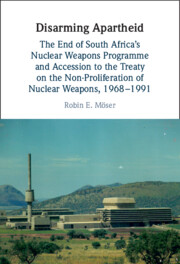 Disarming Apartheid
Disarming Apartheid Published online by Cambridge University Press: 28 March 2024
Chapter 1 begins with a brief sketch of the development of the domestic nuclear energy sector in South Africa (1950–1977). It illuminates how scientists were able to tap into sources of cooperation and funding to advance the nuclear energy industry during the 1960s and 1970s, following the Ploughshare Programme initiated under US President Eisenhower’s Atoms for Peace initiative. Part of this chapter is devoted to the cooperation between South African, French and German firms. Recently obtained primary sources show how these collaborations enabled apartheid scientists to realize their vision of erecting the nuclear infrastructure to produce enriched uranium locally, ultimately feeding their nuclear weapons. I show how internal South African opposition to subjecting its nascent nuclear infrastructure to the emerging global non-proliferation regime manifested itself during that period, with repercussions for the coming decades.
To save this book to your Kindle, first ensure [email protected] is added to your Approved Personal Document E-mail List under your Personal Document Settings on the Manage Your Content and Devices page of your Amazon account. Then enter the ‘name’ part of your Kindle email address below. Find out more about saving to your Kindle.
Note you can select to save to either the @free.kindle.com or @kindle.com variations. ‘@free.kindle.com’ emails are free but can only be saved to your device when it is connected to wi-fi. ‘@kindle.com’ emails can be delivered even when you are not connected to wi-fi, but note that service fees apply.
Find out more about the Kindle Personal Document Service.
To save content items to your account, please confirm that you agree to abide by our usage policies. If this is the first time you use this feature, you will be asked to authorise Cambridge Core to connect with your account. Find out more about saving content to Dropbox.
To save content items to your account, please confirm that you agree to abide by our usage policies. If this is the first time you use this feature, you will be asked to authorise Cambridge Core to connect with your account. Find out more about saving content to Google Drive.